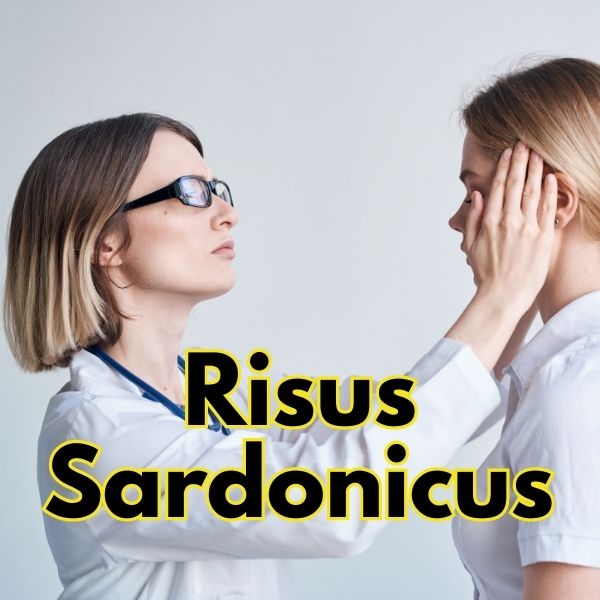Risus Sardonicus: What Is It and How to Treat It?
Have you ever seen someone with a fixed grin on their face that looks unnatural and sinister? This condition is called risus sardonicus or rictus grin, and it is not a sign of amusement or happiness. Rather, it is a symptom of a serious and potentially fatal medical condition that affects the nervous system.
What is Risus Sardonicus
Risus sardonicus is caused by a spasm of the facial muscles that produce a grinning appearance. The spasm is triggered by a neurotoxin that blocks the release of inhibitory neurotransmitters in the brain and spinal cord, resulting in uncontrolled muscle contractions.

What Causes Risus Sardonicus?
The most common source of this toxin is Clostridium tetani, a bacterium that causes tetanus. Tetanus is an infection that can occur when a wound is contaminated with soil or animal feces that contain the bacteria or their spores. The toxin can also be produced by other bacteria, such as Clostridium botulinum (which causes botulism) or Clostridium sordellii (which can cause fatal toxic shock syndrome).
Other possible causes of risus sardonicus include strychnine poisoning, Wilson’s disease (a genetic disorder that affects copper metabolism), and judicial hanging (a form of execution by strangulation).
What are the Symptoms of Risus Sardonicus?
Risus sardonicus is usually one of the first signs of tetanus, which can develop within 3 to 21 days after exposure to the bacteria. Other symptoms of tetanus include:
- Stiffness and pain in the jaw, neck, and back muscles (also known as lockjaw)
- Difficulty swallowing and breathing
- Fever and sweating
- Irritability and restlessness
- Muscle spasms in other parts of the body, such as the abdomen, limbs, and chest
- Seizures and convulsions
- Autonomic instability, such as high blood pressure, rapid heart rate, and irregular heartbeat
Tetanus can also affect newborns (neonatal tetanus) if their umbilical cord is cut with an unsterile instrument or if their mother is not immunized against tetanus. Neonatal tetanus can cause poor sucking reflex, difficulty feeding, excessive crying, muscle rigidity, and spasms.
How to treat risus sardonicus?
Risus sardonicus is a medical emergency that requires immediate treatment. The treatment aims to:
- Neutralize the toxin with an antitoxin injection (such as human tetanus immune globulin)
- Control the muscle spasms with sedatives (such as diazepam) and muscle relaxants (such as baclofen)
- Provide supportive care, such as oxygen therapy, mechanical ventilation, fluid replacement, antibiotics, and wound care
- Prevent complications, such as respiratory failure, cardiac arrest, pneumonia, sepsis, and brain damage
The prognosis of risus sardonicus depends on the severity of the infection, the time of diagnosis and treatment, and the presence of other medical conditions. The mortality rate of tetanus ranges from 10% to 90%, depending on the region and the availability of health care.
How to prevent risus sardonicus?
The best way to prevent risus sardonicus is to prevent tetanus infection by:
- Getting vaccinated against tetanus with a series of shots during childhood and booster doses every 10 years
- Cleaning and disinfecting any wound or injury promptly and thoroughly
- Seeking medical attention if you have a deep or dirty wound or if you are unsure about your vaccination status
- Practicing good hygiene and sanitation
- Avoiding contact with substances that may contain tetanus bacteria or toxins
Risus sardonicus is a rare but serious condition that can be life-threatening if not treated promptly. If you notice any signs of risus sardonicus in yourself or someone else, seek medical help immediately.
References:
- “Tetanus.” World Health Organization, 1 Oct. 2021, https://www.who.int/news-room/q-a-detail/tetanus.
- “Tetanus.” Centers for Disease Control and Prevention, 28 Mar. 2019, https://www.cdc.gov/tetanus/index.html.
FAQs
Q: What is Risus Sardonicus?
A: Risus Sardonicus is a medical condition characterized by involuntary, prolonged contraction of the facial muscles, resulting in a sinister, fixed grin.
Q: What causes Risus Sardonicus?
A: Risus Sardonicus is most commonly caused by tetanus infection, a bacterial infection that affects the nervous system. Other possible causes include strychnine poisoning and facial nerve damage.
Q: What are the symptoms of Risus Sardonicus?
A: The primary symptom of Risus Sardonicus is a sustained, rigid grin, which is often described as “sinister” or “mocking.” Other symptoms may include muscle spasms, rigidity, and difficulty swallowing.
Q: Is Risus Sardonicus fatal?
A: Risus Sardonicus itself is not fatal, but it is a symptom of tetanus infection, which can be fatal if left untreated.
Q: How is Risus Sardonicus treated?
A: Treatment for Risus Sardonicus depends on the underlying cause. If it is caused by tetanus infection, treatment will involve antibiotics, antitoxins, and supportive care to manage symptoms.
Q: Can Risus Sardonicus be prevented?
A: Risus Sardonicus can be prevented by getting vaccinated against tetanus and practicing good wound care to prevent infection. Avoiding the use of illicit drugs that may be contaminated with strychnine can also reduce the risk of developing the condition.
Q: Is Risus Sardonicus contagious?
A: Risus Sardonicus itself is not contagious, but tetanus infection, which can cause the condition, is spread through contact with contaminated objects or soil.
Q: How long does Risus Sardonicus last?
A: The duration of Risus Sardonicus depends on the underlying cause and the effectiveness of treatment. If caused by tetanus infection, symptoms may last for several weeks or months. If caused by other factors, the condition may resolve more quickly.
You May Also Like
- Premenstrual Syndrome (PMS) Explained: Powerful Relief Strategies for 2026
- Magnetic Seizure Therapy (MST): A Breakthrough in Psychiatric Treatment in 2025
- AIIMS New Delhi, NIMHANS Bengaluru, JIPMER Puducherry: No Leaves for Healthcare Workers Amid Tensions
- Narcissistic Personality Disorder in 2025: Unveiling the Hidden Struggles and Empowering Recovery
- Conquering Rubral Tremor: Unveiling Effective Treatments in 2025
